Deck 12: Markov Analysis
Question
Question
Question
Question
Question
Question
Question
Question
Question
Question
Question
Question
Question
Question
Question
Question
Question
Question
Question
Question
Question
Question
Question
Question
Question
Question
Question
Question
Question
Question
Question
Question
Question
Question
Question
Question
Question
Question
Question
Question
Question
Question
Question
Question
Question
Question
Question
Question
Question
Question
Question
Question

Unlock Deck
Sign up to unlock the cards in this deck!
Unlock Deck
Unlock Deck
1/52
Play
Full screen (f)
Deck 12: Markov Analysis
1
Markov Analysis has many business applications, such as accounts receivables analysis and machine maintenance.
True
2
Transition probabilities indicate the tendency of the system to change from one state to another after an elapse of one period.
True
3
Short term behavior of a Markov system depends on the current state and transition probabilities.
True
4
An absorbing state in a Markov system is one in which the system will get stuck and will not be able to get out of that state.

Unlock Deck
Unlock for access to all 52 flashcards in this deck.
Unlock Deck
k this deck
5
Markov systems typically exist for one or two periods.

Unlock Deck
Unlock for access to all 52 flashcards in this deck.
Unlock Deck
k this deck
6
In Markov systems, the probability of going from one state in period to another state in period depends on what states the system traveled in periods , n.

Unlock Deck
Unlock for access to all 52 flashcards in this deck.
Unlock Deck
k this deck
7
The states in a Markov system are mutually exclusive and collectively exhaustive.

Unlock Deck
Unlock for access to all 52 flashcards in this deck.
Unlock Deck
k this deck
8
The columns of the transition probability matrix should add up to 1.0.

Unlock Deck
Unlock for access to all 52 flashcards in this deck.
Unlock Deck
k this deck
9
The rows of a transition probability matrix must add up to 1.0.

Unlock Deck
Unlock for access to all 52 flashcards in this deck.
Unlock Deck
k this deck
10
Short term behavior of a Markov system is determined by its transition probability matrix, while the long term behavior is dependent on the starting state of the system.

Unlock Deck
Unlock for access to all 52 flashcards in this deck.
Unlock Deck
k this deck
11
A tree diagram is a very useful technique for analyzing the long term behavior of a Markov system.

Unlock Deck
Unlock for access to all 52 flashcards in this deck.
Unlock Deck
k this deck
12
If matrix is multiplied by matrix - then the number of rows in should equal the number of columns in B.

Unlock Deck
Unlock for access to all 52 flashcards in this deck.
Unlock Deck
k this deck
13
Judy Jones purchases groceries and pop exactly once each week on Sunday evenings. She buys either Coke or Pepsi only and switches from Coke to Pepsi and vice-versa somewhat regularly. Her purchasing behavior of these two drinks is modeled as a Markov system. Querying Judy, a novice student came up with the following transition mattix. This matrix satisfies all the conditions for being a transition matrix.
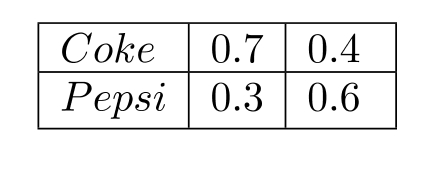


Unlock Deck
Unlock for access to all 52 flashcards in this deck.
Unlock Deck
k this deck
14
A transient state in a Markov chain is one in which the system cannot stay in for the long run.

Unlock Deck
Unlock for access to all 52 flashcards in this deck.
Unlock Deck
k this deck
15
A state or a group of states in a Markov chain is called absorbing if the system can never get out of that state or the group of states (if it ever reaches it).

Unlock Deck
Unlock for access to all 52 flashcards in this deck.
Unlock Deck
k this deck
16
In Markov chains having absorbing states and transient states, in order to compute probability of absorption in an absorbing state starting from a transient state, the matrix is partitioned into two submatrices.

Unlock Deck
Unlock for access to all 52 flashcards in this deck.
Unlock Deck
k this deck
17
Inverse of a matrix exists even if the matrix in not a square matrix.

Unlock Deck
Unlock for access to all 52 flashcards in this deck.
Unlock Deck
k this deck
18
If there are only two absorbing states and three transient states, we can add a dummy absorbing state to make the matrix I-Q into a square matrix.

Unlock Deck
Unlock for access to all 52 flashcards in this deck.
Unlock Deck
k this deck
19
Newsweek and Time are two competing, weeklies each of which tries to keep their readership while at the same time trying to get the other's readers to switch. Among all the households holding yearly subscriptions to Newsweek or Time (but not both), let and denote the states that a household is a current Newsweek or Time subscriber, respectively. The probabilities of switching from one state to the other after one transition (when they renew) are given by the tree diagram. (For simplicity, it may be assumed that all annual subscriptions expire on December 31st and are renewed by all of them for one or the other but not both magazines for one year.) If the current number of households subscribing to Newsweek and Time is 2000 and 4000, respectively, Time would have a larger number of subscribers in the long run.
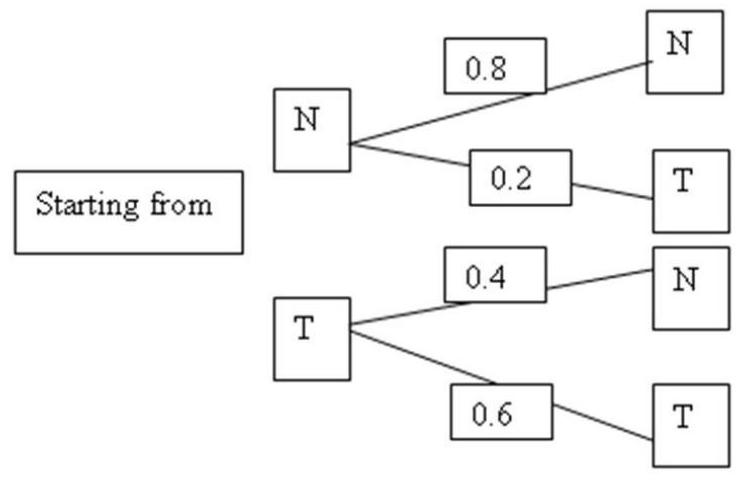


Unlock Deck
Unlock for access to all 52 flashcards in this deck.
Unlock Deck
k this deck
20
Newsweek and Time are two competing, weeklies each of which tries to keep their readership while at the same time trying to get the other's readers to switch. Among all the households holding yearly subscriptions to Newsweek or Time (but not both), let and denote the states that a household is a current Newsweek or Time subscriber, respectively. The probabilities of switching from one state to the other after one transition (when they renew) are given by the tree diagram. (For simplicity, it may be assumed that all annual subscriptions expire on December 31st and are renewed by all of them for one or the other but not both magazines for one year.) If the current number of households subscribing to Newsweek and Time is 8000 and 4000, respectively, Newsweek would have a larger number of subscribers in the long run.
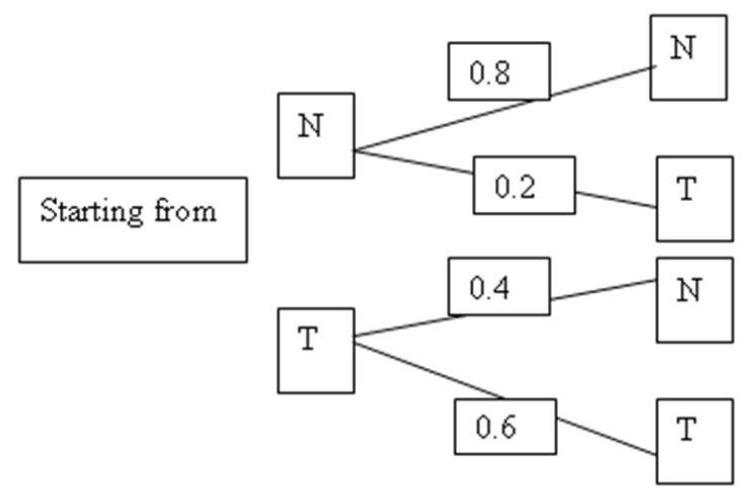


Unlock Deck
Unlock for access to all 52 flashcards in this deck.
Unlock Deck
k this deck
21
Newsweek and Time are two competing weeklies, each of which tries to keep their readership while trying to get the other's readers to switch. Among all the households holding yearly subscription to Newsweek or Time but not both, let and denote the states that a household is a current Newsweek or Time subscriber, respectively. The probabilities of switching from one state to the other after one transition (when they renew) are given by the tree diagram. (For simplicity, it may be assumed that all annual subscriptions expire on December 31st of the year and are renewed by all of them for one or the other but not both magazines for one year.) If the current number of households subscribing for Newsweek and Time respectively was 4000 and 2000, then both magazines would have the same number of subscribers in the very long run.
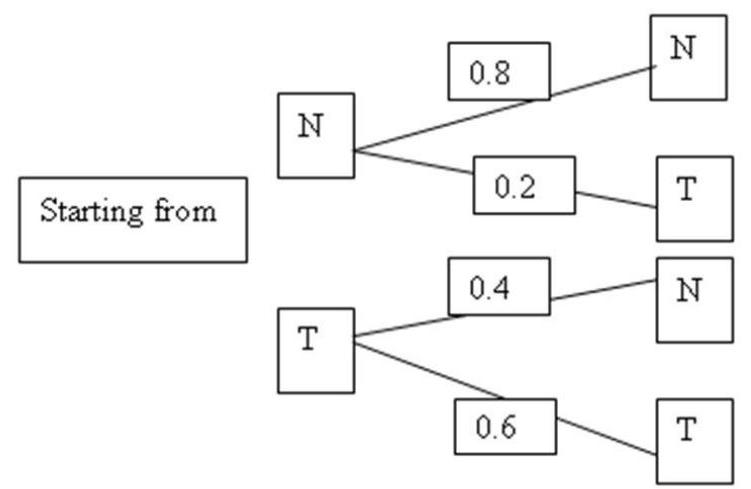


Unlock Deck
Unlock for access to all 52 flashcards in this deck.
Unlock Deck
k this deck
22
XYZ Inc. hires only retired people for its greeter's job. They always start on January 1 and are considered for promotion every January 1st thereafter. On every January 1st, any existing greeter (state G) - those who were greeters last year - may be retired (state R), may be dead (sate D), may continue as a greeter (state G), or may be promoted as greeter -in-chief (state GIC). Persons in state GIC may continue in it or move to states or in one year. The following is the transition matrix. This matrix has a set of cyclical states, namely states 3 and 4 .



Unlock Deck
Unlock for access to all 52 flashcards in this deck.
Unlock Deck
k this deck
23
XYZ Inc. hires only retired people for its greeter's job. They always start on January 1 and are considered for promotion every January 1st thereafter. On every January 1st, any existing greeter (state G) - those who were greeters last year - may be retired (state R), may be dead (sate D), may continue as a greeter (state G), or may be promoted as greeter -in-chief (state GIC). Persons in state GIC may continue in it or move to states or in one year. The following is the transition matrix. This matrix has three transient states.



Unlock Deck
Unlock for access to all 52 flashcards in this deck.
Unlock Deck
k this deck
24
XYZ Inc. hires only retired people for its greeter's job. They always start on January 1 and are considered for promotion every January 1st thereafter. On every January 1st, any existing greeter (state G) those who were greeters last year - may be retired (state R), may be dead (sate D), may continue as a greeter (state G), or may be promoted as greeter -in-chief (state GIC). Persons in state GIC may continue in it or move to states D or R in one year. The following is the transition matrix. As per this matrix, more greeters will eventually retire from service as compared to the number who eventually die while in service.



Unlock Deck
Unlock for access to all 52 flashcards in this deck.
Unlock Deck
k this deck
25
Which of the following is not a part of the characteristics of a Markov system?
A) In each period the system can assume one of a number of states
B) Transition probabilities describing the system changes from period to period remain constant
C) The states of the system overlap
D) The probability of going from a state in period to another state in period depends only on the current state of the system
A) In each period the system can assume one of a number of states
B) Transition probabilities describing the system changes from period to period remain constant
C) The states of the system overlap
D) The probability of going from a state in period to another state in period depends only on the current state of the system

Unlock Deck
Unlock for access to all 52 flashcards in this deck.
Unlock Deck
k this deck
26
Judy Jones purchases groceries and pop exactly once each week on Sunday evenings. She buys either Coke or Pepsi only and switches from Coke to Pepsi and vice-versa somewhat regularly. Her purchasing behavior of these two drinks is modeled as a Markov system. The number of states required to model the system is
A) 2
B) 1
C) 4
D) 3
A) 2
B) 1
C) 4
D) 3

Unlock Deck
Unlock for access to all 52 flashcards in this deck.
Unlock Deck
k this deck
27
Judy Jones purchases groceries and pop exactly once each week on Sunday evenings. She buys either Coke or Pepsi only and switches from Coke to Pepsi and vice-versa somewhat regularly. Her purchasing behavior of these two drinks is modeled as a Markov system. Let the transition matrix be:

If in Week \#7, Judy has purchased Coke, what is the probability that she would purchase Pepsi in Week ?
A) 0.7
B) 0.6
C) 0.3
D) cannot tell without her purchase behavior in Weeks 1-6

If in Week \#7, Judy has purchased Coke, what is the probability that she would purchase Pepsi in Week ?
A) 0.7
B) 0.6
C) 0.3
D) cannot tell without her purchase behavior in Weeks 1-6

Unlock Deck
Unlock for access to all 52 flashcards in this deck.
Unlock Deck
k this deck
28
Judy Jones purchases groceries and pop exactly once each week on Sunday evenings. She buys either Coke or Pepsi only and switches from Coke to Pepsi and vice-versa somewhat regularly. Her purchasing behavior of these two drinks is modeled as a Markov system. Let the transition matrix be:

If in Week \#7, Judy has purchased Coke, what is the probability that she would purchase Pepsi in Week ?
A) 0.21
B) 0.39
C) 0.18
D) cannot tell without her purchase behavior in Weeks 1-6

If in Week \#7, Judy has purchased Coke, what is the probability that she would purchase Pepsi in Week ?
A) 0.21
B) 0.39
C) 0.18
D) cannot tell without her purchase behavior in Weeks 1-6

Unlock Deck
Unlock for access to all 52 flashcards in this deck.
Unlock Deck
k this deck
29
A study was made about the incidence of hard-working fathers having lazy sons and lazy fathers having hard-working sons among several generations of families having only one son. It was hypothesized (based on a preliminary study) that a Markov chain model described below will fit the profile from one generation to the next.

If in a particular generation the father was hard-working, what is the probability that his son would be lazy?
A) 0.2
B) 0.8
C) 0.9
D) cannot tell without information about the grandfather

If in a particular generation the father was hard-working, what is the probability that his son would be lazy?
A) 0.2
B) 0.8
C) 0.9
D) cannot tell without information about the grandfather

Unlock Deck
Unlock for access to all 52 flashcards in this deck.
Unlock Deck
k this deck
30
Judy Jones purchases groceries and pop exactly once each week on Sunday evenings. She buys either Coke or Pepsi only and switches from Coke to Pepsi and vice-versa somewhat regularly. Her purchasing behavior of these two drinks is modeled as a Markov system. Let the transition matrix be:

Let Coke and respectively denote the steady state probability that Judy will buy Coke or Pepsi in the very long run on any week. Which of the following is the correct system of equations to find these steady state probabilities?
A) Coke Pepsi Coke and Coke Pepsi Pepsi
B) Coke Pepsi Coke and Coke Pepsi Pepsi
C) Coke Pepsi Pepsi and Coke Pepsi Coke
D) Coke Pepsi Coke and Coke Pepsi

Let Coke and respectively denote the steady state probability that Judy will buy Coke or Pepsi in the very long run on any week. Which of the following is the correct system of equations to find these steady state probabilities?
A) Coke Pepsi Coke and Coke Pepsi Pepsi
B) Coke Pepsi Coke and Coke Pepsi Pepsi
C) Coke Pepsi Pepsi and Coke Pepsi Coke
D) Coke Pepsi Coke and Coke Pepsi

Unlock Deck
Unlock for access to all 52 flashcards in this deck.
Unlock Deck
k this deck
31
Judy Jones purchases groceries and pop exactly once each week on Sunday evenings. She buys either Coke or Pepsi only and switches from Coke to Pepsi and vice-versa somewhat regularly. Her purchasing behavior of these two drinks is modeled as a Markov system. Let the transition matrix be:

If in Week\#7, Judy is equally likely to be purchasing Coke or Pepsi (0.5 each), what is the probability that she would purchase Pepsi in Week \#8?
A) 0.45
B) 0.55
C) 0.5
D) 0.3

If in Week\#7, Judy is equally likely to be purchasing Coke or Pepsi (0.5 each), what is the probability that she would purchase Pepsi in Week \#8?
A) 0.45
B) 0.55
C) 0.5
D) 0.3

Unlock Deck
Unlock for access to all 52 flashcards in this deck.
Unlock Deck
k this deck
32
Judy Jones purchases groceries and pop exactly once each week on Sunday evenings. She buys either Coke or Pepsi only and switches from Coke to Pepsi and vice-versa somewhat regularly. Her purchasing behavior of these two drinks is modeled as a Markov system. Let the transition matrix be:

Let Coke) and respectively denote the steady state probability that Judy will buy Coke or Pepsi in the very long run on any week. P(Coke) for this data will be
A) 0.7
B) 0.6
C)
D)

Let Coke) and respectively denote the steady state probability that Judy will buy Coke or Pepsi in the very long run on any week. P(Coke) for this data will be
A) 0.7
B) 0.6
C)
D)

Unlock Deck
Unlock for access to all 52 flashcards in this deck.
Unlock Deck
k this deck
33
Judy Jones purchases groceries and pop exactly once each week on Sunday evenings. She buys either Coke or Pepsi only and switches from Coke to Pepsi and vice-versa somewhat regularly. Her purchasing behavior of these two drinks is modeled as a Markov system. Let the transition matrix be:

In the next 700 weeks, on an average, how many weeks is Judy expected to purchase Pepsi?
A) 400
B) 420
C) 300
D) 210

In the next 700 weeks, on an average, how many weeks is Judy expected to purchase Pepsi?
A) 400
B) 420
C) 300
D) 210

Unlock Deck
Unlock for access to all 52 flashcards in this deck.
Unlock Deck
k this deck
34
Vikram eats a sandwich for dinner every Sunday. He only likes Papa John's or Potbelly. His behavior in this context is captured by the following Markov transition matrix.

In the next 90 Sundays, on an average, how many Sundays would Vikram have eaten at Papa Johns?
A) 40
B) 50
C) 45
D) 36

In the next 90 Sundays, on an average, how many Sundays would Vikram have eaten at Papa Johns?
A) 40
B) 50
C) 45
D) 36

Unlock Deck
Unlock for access to all 52 flashcards in this deck.
Unlock Deck
k this deck
35
Vikram eats a sandwich for dinner every Sunday. He only likes Papa John's or Potbelly. His behavior in this context is captured by the following Markov transition matrix.

Suppose on the first Sunday of 2006, Vikram ate in Potbelly, what is the probability that he would eat Potbelly's on the second Sunday of 2006?
A) 0.4
B) 0.5
C) 0.6
D) cannot tell

Suppose on the first Sunday of 2006, Vikram ate in Potbelly, what is the probability that he would eat Potbelly's on the second Sunday of 2006?
A) 0.4
B) 0.5
C) 0.6
D) cannot tell

Unlock Deck
Unlock for access to all 52 flashcards in this deck.
Unlock Deck
k this deck
36
Vikram eats a sandwich for dinner every Sunday. He only likes Papa John's or Potbelly. His behavior in this context is captured by the following Markov transition matrix.

Suppose on the first Sunday of 2006, Vikram ate in Potbelly, what is the probability that he would eat there on the third Sunday of 2006?
A) 0.5
B) 0.44
C) 0.56
D) 0.6

Suppose on the first Sunday of 2006, Vikram ate in Potbelly, what is the probability that he would eat there on the third Sunday of 2006?
A) 0.5
B) 0.44
C) 0.56
D) 0.6

Unlock Deck
Unlock for access to all 52 flashcards in this deck.
Unlock Deck
k this deck
37
Joe Smith, a loyal lessee of American cars, changes cars exactly once every two years. Joe leases either a Ford or a Chrysler only. His leasing behavior is modeled as a Markov chain, and the transition matrix is given below.

If in year 4 (3rd lease), Joe is equally likely to be leasing a Ford or a Chrysler (0.5 each), what is the probability that he would lease a Chrysler next time (4th lease)?
A) 0.45
B) 0.55
C) 0.5
D) 0.3

If in year 4 (3rd lease), Joe is equally likely to be leasing a Ford or a Chrysler (0.5 each), what is the probability that he would lease a Chrysler next time (4th lease)?
A) 0.45
B) 0.55
C) 0.5
D) 0.3

Unlock Deck
Unlock for access to all 52 flashcards in this deck.
Unlock Deck
k this deck
38
Joe Smith, a loyal lessee of American cars, changes cars exactly once every two years. Joe leases either a Ford or a Chrysler only. His leasing behavior is modeled as a Markov chain, and the transition matrix is given below.

Let (Ford) and Chrysler) respectively denote the steady state probability that Joe will lease a Ford or a Chrysler in the long run. P(Ford) for this data will be
A) 0.7
B) 0.6
C)
D)

Let (Ford) and Chrysler) respectively denote the steady state probability that Joe will lease a Ford or a Chrysler in the long run. P(Ford) for this data will be
A) 0.7
B) 0.6
C)
D)

Unlock Deck
Unlock for access to all 52 flashcards in this deck.
Unlock Deck
k this deck
39
Jim Cramer, a stock analyst, models the movement of the closing price in NYSE of the stock WidgetsR-Us Inc. (symbol: WRU) as a Markov chain with a transition time of 1 day. There are two states in this Markov system-State A, the closing price increased or stayed the same from the previous day and State , the closing price decreased from the previous day. Suppose that the system is on State A at the end of today, what is the probability that it will be in State A after two trading days (48 hours)?
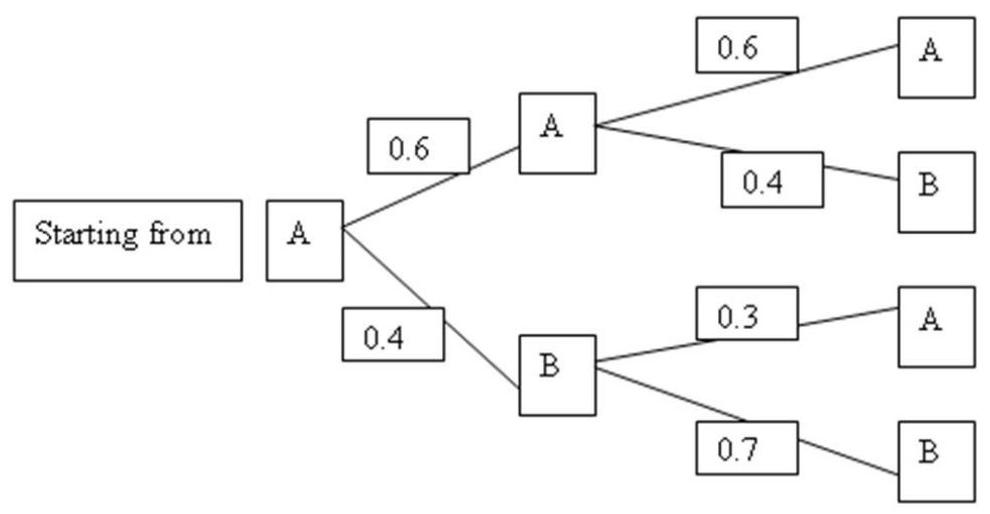
A) 0.36
B) 0.24
C) 0.12
D) 0.48

A) 0.36
B) 0.24
C) 0.12
D) 0.48

Unlock Deck
Unlock for access to all 52 flashcards in this deck.
Unlock Deck
k this deck
40
Jim Cramer, a stock analyst, models the movement of the closing price in NYSE of the stock WidgetsR-Us Inc. (symbol: WRU) as a Markov chain with a transition time of 1 day. There are two states in this Markov system-State A, the closing price increased or stayed the same from the previous day and State B, the closing price decreased from the previous day. Suppose that the system is on State A at the end of today, what is the probability that it will be in State B after two trading days (48 hours)?
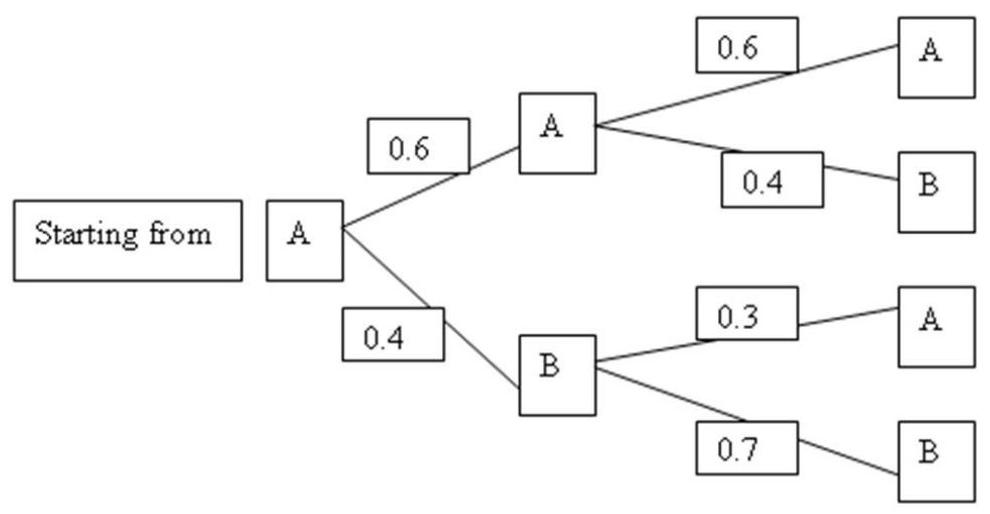
A) 0.52
B) 0.24
C) 0.28
D) 0.40

A) 0.52
B) 0.24
C) 0.28
D) 0.40

Unlock Deck
Unlock for access to all 52 flashcards in this deck.
Unlock Deck
k this deck
41
Jim Cramer, a stock analyst, models the movement of the closing price in NYSE of the stock WidgetsR-Us Inc. (symbol: WRU) as a Markov chain with a transition time of 1 day. There are two states in this Markov system-State A, the closing price increased or stayed the same from the previous day and State , the closing price decreased from the previous day. Suppose that the system is on State B as at the end of today, what is the probability that it will be in State B after two trading days (48 hours)?
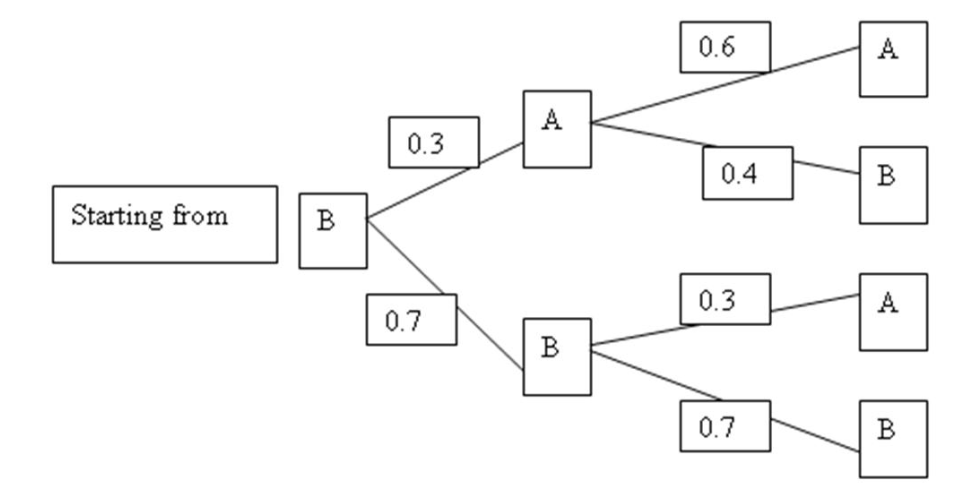
A) 0.52
B) 0.24
C) 0.28
D) 0.40

A) 0.52
B) 0.24
C) 0.28
D) 0.40

Unlock Deck
Unlock for access to all 52 flashcards in this deck.
Unlock Deck
k this deck
42
Newsweek and Time are two competing weeklies, each of which tries to keep their readership while trying to get the other's readers to switch. Among all the households holding yearly subscription to Newsweek or Time but not both, let and denote the states that a household is a current Newsweek or Time subscriber, respectively. The probabilities of switching from one state to the other after one transition (when they renew) are given by the tree diagram. (For simplicity, it may be assumed that all annual subscriptions expire on December 31st of the year and are renewed by all of them for one or the other but not both magazines for one year.) If the current number of households subscribing for Newsweek and Time is, respectively 2000 and 3000, what would be the number of subscribers to Newsweek after one renewal?
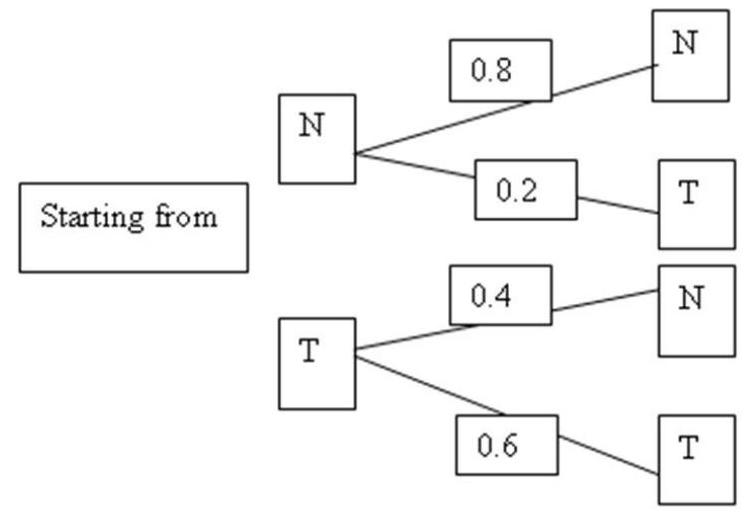
A) 0.80
B) 1600
C) 2800
D) 2200

A) 0.80
B) 1600
C) 2800
D) 2200

Unlock Deck
Unlock for access to all 52 flashcards in this deck.
Unlock Deck
k this deck
43
Newsweek and Time are two competing weeklies, each of which tries to keep their readership while trying to get the other's readers to switch. Among all the households holding yearly subscription to Newsweek or Time but not both, let and denote the states that a household is a current Newsweek or Time subscriber, respectively. The probabilities of switching from one state to the other after one transition (when they renew) are given by the tree diagram. (For simplicity, it may be assumed that all annual subscriptions expire on December 31st of the year and are renewed by all of them for one or the other but not both magazines for one year.) If the current number of households subscribing for Newsweek and Time is, respectively, 2000 and 3000, what would be the number of subscribers to Time after two renewals?
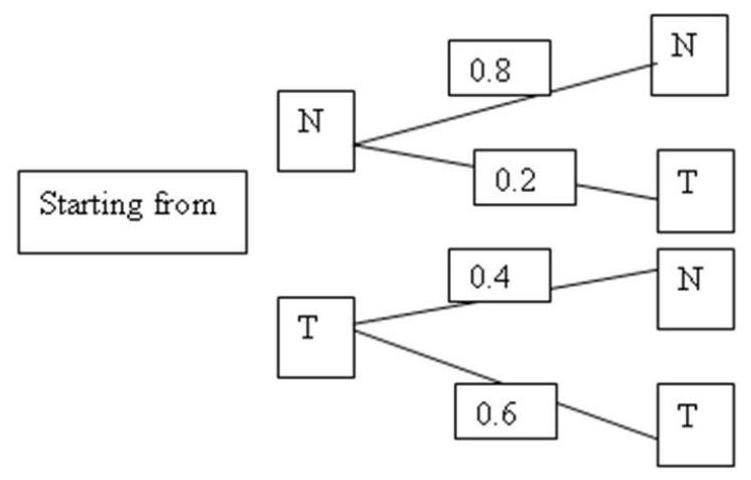
A) 1680
B) 3320
C) 2800
D) 2200

A) 1680
B) 3320
C) 2800
D) 2200

Unlock Deck
Unlock for access to all 52 flashcards in this deck.
Unlock Deck
k this deck
44
Newsweek and Time are two competing weeklies, each of which tries to keep their readership while trying to get the other's readers to switch. Among all the households holding yearly subscription to Newsweek or Time but not both, let and denote the states that a household is a current Newsweek or Time subscriber, respectively. The probabilities of switching from one state to the other after one transition (when they renew) are given by the tree diagram. (For simplicity, it may be assumed that all annual subscriptions expire on December 31st of the year and are renewed by all of them for one or the other but not both magazines for one year.) If the current number of households subscribing for Newsweek and Time is respectively 2000 and 4000, what would be the number of subscribers to Newsweek in the steady state, that is after very many renewals?
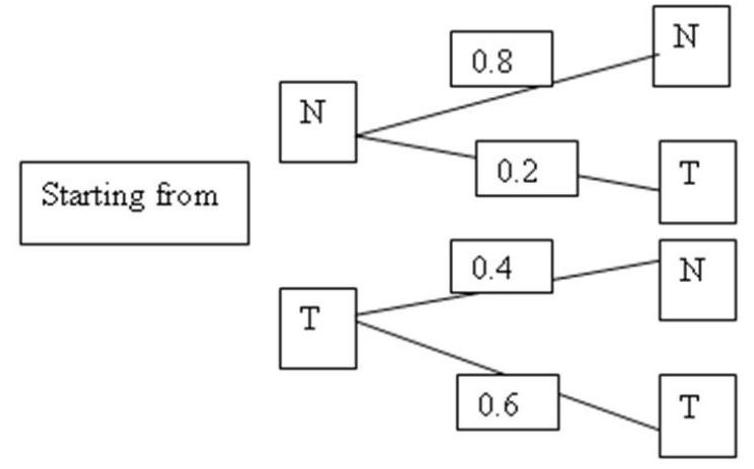
A) 2000
B) 4000
C) 3300
D) 4400

A) 2000
B) 4000
C) 3300
D) 4400

Unlock Deck
Unlock for access to all 52 flashcards in this deck.
Unlock Deck
k this deck
45
XYZ Inc. hires only retired people for its greeter's job. They always start on January 1 and are considered for promotion every January 1st thereafter. On every January 1st, any existing greeter (state G) - those who were greeters last year- may be retired (state R), may be dead (sate D), may continue as a greeter (state G), or may be promoted as greeter -in-chief (state GIC). Persons in state GIC may continue in it or move to states or in one year. The table below is the transition matrix; use 1 year as the transition time. The number of transient and absorbing states in this matrix is:

A) 2 and 4
B) 2 and 2
C) 4 and 2
D) 4 and 4

A) 2 and 4
B) 2 and 2
C) 4 and 2
D) 4 and 4

Unlock Deck
Unlock for access to all 52 flashcards in this deck.
Unlock Deck
k this deck
46
XYZ Inc. hires only retired people for its greeter's job. They always start on January 1 and are considered for promotion every January 1st thereafter. On every January 1st, any existing greeter (state G) - those who were greeters last year - may be retired (state R), may be dead (sate D), may continue as a greeter (state G), or may be promoted as greeter -in-chief (state GIC). Persons in state GIC may continue in it or move to states or in one year. Using the data on transition matrix and using 1 year as the transition time, the probability of a greeter retiring eventually is the probability of a greeter being dead eventually. (Note: a person may retire and then die, and it will be still counted as retired)

A) greater than
B) less than
C) equal to
D) either greater or less but not equal

A) greater than
B) less than
C) equal to
D) either greater or less but not equal

Unlock Deck
Unlock for access to all 52 flashcards in this deck.
Unlock Deck
k this deck
47
XYZ Inc. hires only retired people for its greeter's job. They always start on January 1 and are considered for promotion every January 1st thereafter. On every January 1st, any existing greeter (state G) those who were greeters last year - may be retired (state R), may be dead (sate D), may continue as a greeter (state G), or may be promoted as greeter -in-chief (state GIC). Persons in state GIC may continue in it or move to states D or R in one year. The following is the transition matrix. While trying to find the probability of eventual absorption in the absorbing states, Matrix for this problem is:
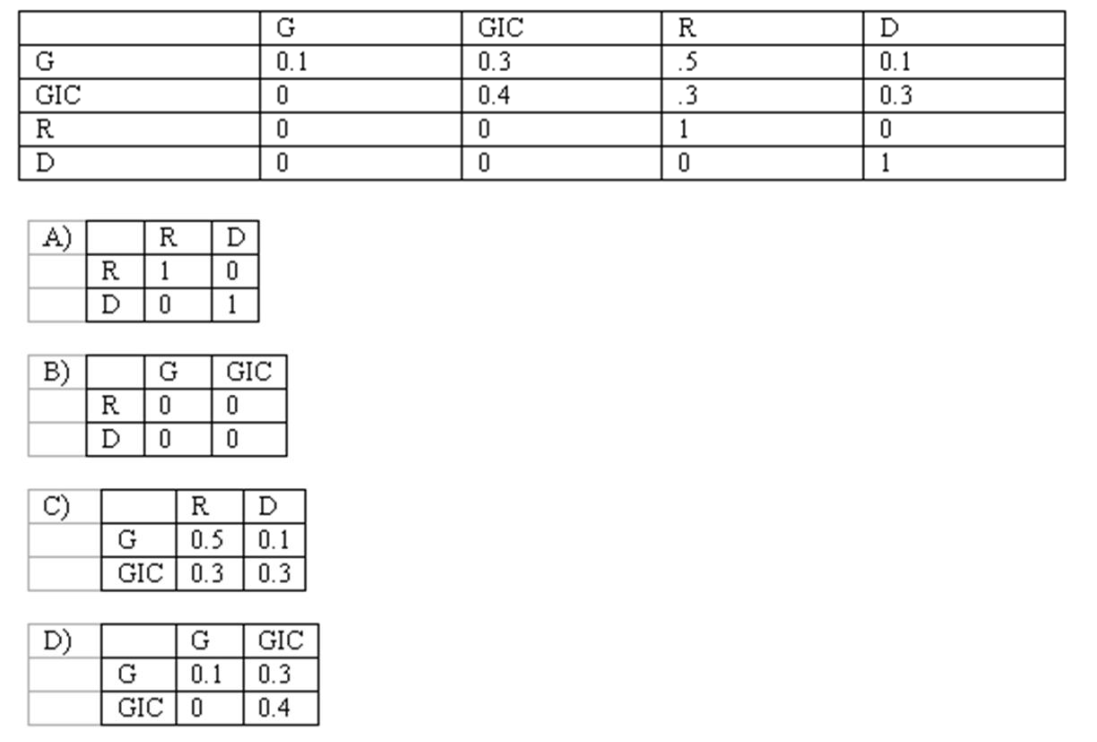
A) See A Above
B) See B Above
C) See C Above
D) See D Above

A) See A Above
B) See B Above
C) See C Above
D) See D Above

Unlock Deck
Unlock for access to all 52 flashcards in this deck.
Unlock Deck
k this deck
48
XYZ Inc. hires only retired people for its greeter's job. They always start on January 1 and are considered for promotion every January 1st thereafter. On every January 1st, any existing greeter (state G) those who were greeters last year - may be retired (state R), may be dead (sate D), may continue as a greeter (state G), or may be promoted as greeter -in-chief (state GIC). Persons in state GIC may continue in it or move to states D or R in one year. The following is the transition matrix. While trying to find the probability of eventual absorption in the absorbing states, Matrix R for this problem is:

A) See A Above
B) See B Above
C) See C Above
D) See D Above

A) See A Above
B) See B Above
C) See C Above
D) See D Above

Unlock Deck
Unlock for access to all 52 flashcards in this deck.
Unlock Deck
k this deck
49
XYZ Inc. hires only retired people for its greeter's job. They always start on January 1 and are considered for promotion every January 1st thereafter. On every January 1st, any existing greeter (state G) those who were greeters last year - may be retired (state R), may be dead (sate D), may continue as a greeter (state G), or may be promoted as greeter -in-chief (state GIC). Persons in state GIC may continue in it or move to states or in one year. The following is the transition matrix. While trying to find the probability of eventual absorption in the absorbing states, Matrix for this problem is:
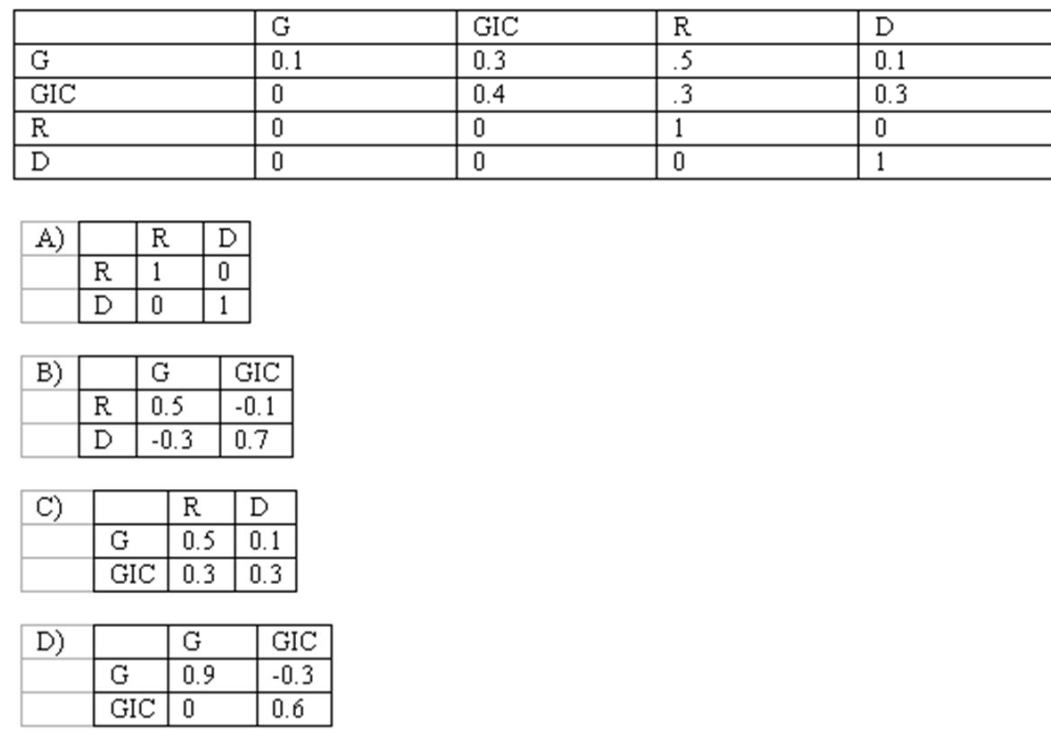
A) See A Above
B) See B Above
C) See C Above
D) See D Above

A) See A Above
B) See B Above
C) See C Above
D) See D Above

Unlock Deck
Unlock for access to all 52 flashcards in this deck.
Unlock Deck
k this deck
50
XYZ Inc. hires only retired people for its greeter's job. They always start on January 1 and are considered for promotion every January 1st thereafter. On every January 1st, any existing greeter (state G) those who were greeters last year - may be retired (state R), may be dead (sate D), may continue as a greeter (state G), or may be promoted as greeter -in-chief (state GIC). Persons in state GIC may continue in it or move to states or in one year. The following is the transition matrix. While trying to find the probability of eventual absorption in the absorbing states, Matrix N = (I-Q)-1 for this problem is:
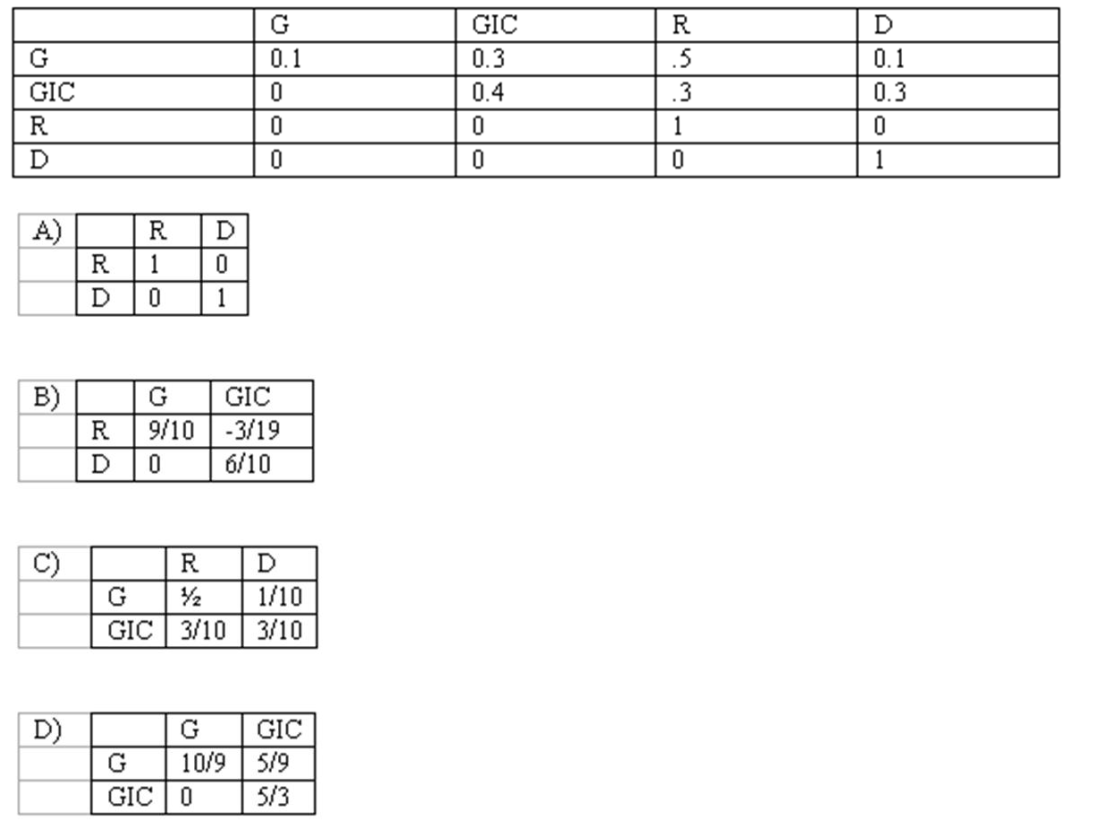
A) See A Above
B) See B Above
C) See C Above
D) See D Above

A) See A Above
B) See B Above
C) See C Above
D) See D Above

Unlock Deck
Unlock for access to all 52 flashcards in this deck.
Unlock Deck
k this deck
51
Goldman Sachs commodity analyst John Roberts wanted to use Markov Chains to analyze the price movement of gold. He looked at the changes in the closing price per ounce of gold bullion in the Chicago Board of Trade for any two consecutive trading days. He recognized three states: U (up): today's closing price - previous closing price (neutral): today's closing price - previous closing price ; and D (down): today's closing price - previous closing price . John goes on to construct a transition matrix based on these state definitions; the matrix is given below.

(A) Draw a tree diagram showing the choices for two periods, starting from and .
(B) If the current state of the bullion market were , what would be the probability distribution for the states occupied by the bullion market after 2 trading days?
(C) What would be the long-run proportions (steady-state probabilities) for each state?
(D) In a five-year period with 1,201 trading days, how many of these days would you expect the system to be in U state?

(A) Draw a tree diagram showing the choices for two periods, starting from and .
(B) If the current state of the bullion market were , what would be the probability distribution for the states occupied by the bullion market after 2 trading days?
(C) What would be the long-run proportions (steady-state probabilities) for each state?
(D) In a five-year period with 1,201 trading days, how many of these days would you expect the system to be in U state?

Unlock Deck
Unlock for access to all 52 flashcards in this deck.
Unlock Deck
k this deck
52
The U.S. army hires only newly minted graduates for a special officer program. They always start on January 1 and are considered for promotion every January 1st thereafter. On January 1st, existing officers (state O) - those who were officers last year-may continue as officers, be promoted to manager cadres (state M), retire (state R ), or be dead while in service (state D). Everyone in state M on January 1st may continue in state or move to states or . Using the data from the transition matrix and using 1 year as the transition time, calculate the probability of an officer eventually being retired or dead while in service. Similarly, calculate the probability of a manager eventually being retired or dead while in service.



Unlock Deck
Unlock for access to all 52 flashcards in this deck.
Unlock Deck
k this deck



